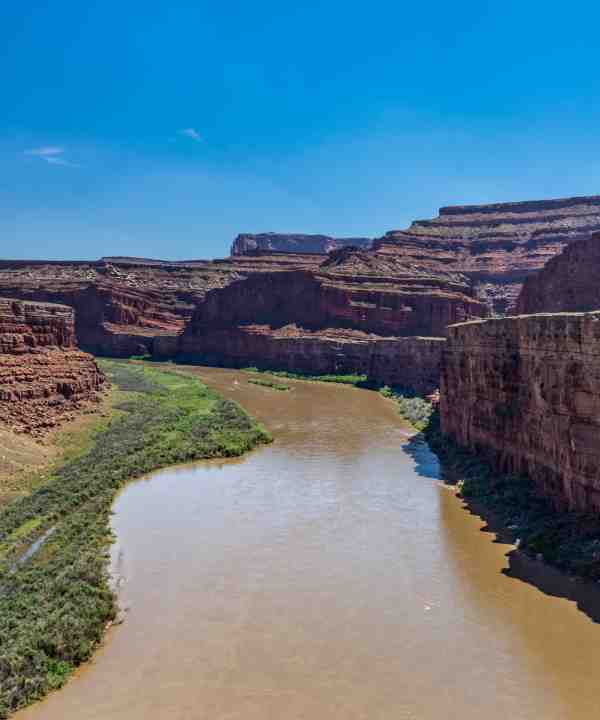August 30, 2022 | Water in the West | News
At a time of unprecedented aridification across the American West, the 1,450-mile-long Colorado River and its primary storage reservoirs — Lake Powell and Lake Mead — have fallen to historic lows.
Fragile ecosystems that depend on the river for water, food and habitat are in peril. In fact, at least 44 of 49 freshwater fish species native to the basin are now endangered, threatened, or extinct.
“When water supplies run short, the environment tends to lose,” said Philip Womble, a postdoctoral fellow with the Stanford Woods Institute for the Environment. “In an overallocated system, the environment is usually the first use of water that gets left out.”
Environmental water transactions — when owners of water rights are paid to leave water in the river — could provide a solution. However, states have been slow to enact laws that enable these transactions. Many states now recognize environmental water rights, but formal transfers that reallocate water rights from agriculture or other uses to the environment must still navigate complex, time-consuming laws and processes that frequently do not apply to other types of water use. As a result, some scholars and analysts have assumed that states with poor legal frameworks may be less able to respond to the current crisis.
Womble and his colleagues at the University of Virginia studied water transactions in five Colorado River Basin states between 2014 and 2020 to better understand how — and how frequently — they actually occur. Their article, "Decoupling environmental water markets from water law," recently published in Environmental Research Letters, found that substantial numbers of environmental water transactions have taken place, including in states with more restrictive laws. Furthermore, 95 percent of the 446 water transactions recorded during the study period occurred outside of the states’ formal legal processes.
Womble and his colleagues found that environmental water transactions take place in spite of the hurdles, largely by sidestepping states’ legal processes. What’s more, most of these transactions didn’t represent purely private sales of water rights, but rather, they were initiated by government programs that aim to protect species or conserve water. In fact, government spending was the dominant funding source, representing 90 percent of the $53 million spent on transactions during the study period, 68 percent of which came from the federal government.
“Restrictive state law has not blocked environmental water transactions from occurring because conservation organizations have found ways to acquire water for the environment without going through the formal legal process to transfer water rights to instream use,” Womble said. “By simply paying water users not to take their entire allocation and leave it in the river, they're able to sidestep that process.”
Womble and his colleagues looked at water market transactions that explicitly acquired water for some ecological objective, commonly fish habitat, but they also included water transactions that simply left water in the river to reduce consumption in the system. All of these transactions could benefit the environment while simultaneously relieving pressure on a strained system for the benefit of all users.
The importance of Womble’s findings increased dramatically in June, when the Bureau of Reclamation, intent on preventing Lakes Mead and Powell from falling to critically low levels, asked all Colorado River basin states to present a plan to reduce their water use by 2-4 million acre-feet in 2022 and 2023, a sum that represents roughly 15-33 percent of the river’s recent flows. It is widely expected that water transactions that leave water in the river will form a significant part of the response.
Womble said the conclusions of his study point to a solution that could simultaneously help states meet the Bureau’s mandated reductions and relieve pressure on the environment. And yet while promising, the team’s analysis determined that the current level of market activity is insufficient to stave off future curtailments. Instead of waiting until states streamline their water transfer laws, Womble’s results show that significant investments in water transactions can happen now.
“Our data show that if market-based mechanisms are going to play a major role in solving water shortages, both in the Colorado River specifically and across the Southwest, they need to expand significantly,” Womble said.
And while the Bureau has asked all states to reduce water use significantly in 2022 and 2023, upper basin states may be uniquely vulnerable, since they are required by the hundred-year-old Colorado River Compact to deliver a certain amount of water downstream to cities and farms in California and other states. If they fail to meet those targets, the City of Denver and other major users in the upper basin could face painful cuts.
The study concludes that the market needs to be scaled up to as much as 24 times its current size to avoid curtailment, a volume of water that would require around $90 million per year in new investment to finance.
The Inflation Reduction Act that President Biden signed into law this month contains $4 billion to lease or buy water from farmers and other water users, primarily in the Colorado River system, to stabilize the system’s dwindling reservoir supplies. Basin states, tribes, and the U.S. government are in discussions to determine how those funds can best be utilized.
Decoupling environmental water markets from water law
Media Contacts:
Philip Womble, Water in the West at Stanford University: pjwomble@stanford.edu
Tom Johnson, Water in the West at Stanford University: (970) 215-3459; twj11@stanford.edu


![[Woods Logo]](/sites/default/files/logos/footer-logo-woods.png)
![[Bill Lane Center Logo]](/sites/default/files/logos/footer-logo-billlane.png)